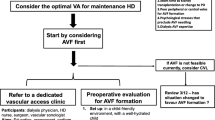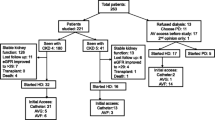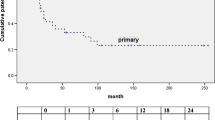Abstract
Background
Transitions from peritoneal dialysis (PD) to haemodialysis (HD) are often unpredictable and central venous catheters (CVCs) are frequently required. Early studies found few back-up arteriovenous fistulas (bAVFs) were ever used. The PD population’s characteristics have changed over time which may have altered the likelihood of bAVFs being used. This study aimed to report use of, and outcomes associated with, bAVFs in a contemporary cohort of peritoneal dialysis patients.
Method
A single-centre, retrospective study of PD patients commencing dialysis between 2006–2016, stratified according to presence/absence of bAVF.
Results
One hundred seventy-six patients were included—82 with bAVF, 94 without bAVF—of whom 156 transitioned off PD. Transitions were to HD (49%), transplantation (23%), death (15%) and renal-recovery (1%). 51% of bAVFs were successfully used and 82% of bAVFs were patent when required. Median time from creation to bAVF use was 2.5 years. More patients with a bAVF transitioned to HD (62 vs 38%, p < 0.005). However, CVC requirement at the time of transition to HD was much less common in the bAVF group (18 vs 83%, p < 0.0001), such that the overall risk of requiring a CVC was significantly lower in the bAVF group (11 vs 31%, p < 0.005). Rates of returning to PD amongst patients who transitioned to HD with a CVC or an AVF were similar (19 vs 26%, p = 0.16).
Conclusions
In this cohort of PD patients, utilisation of back-up arteriovenous fistulas was higher than previously reported, and presence of a back-up arteriovenous fistula was associated with a lower rate of future CVC use.

Similar content being viewed by others
Availability of data and material
Deidentified data is available from the corresponding author.
Code availability
Not applicable.
References
41st Annual ANZDATA Report (2018) Peritoneal dialysis
Descoeudres B, Koller MT, Garzoni D, Wolff T, Steiger J, Schaub S et al (2008) Contribution of early failure to outcome on peritoneal dialysis. Perit Dial Int 28(3):259–267
Lan PG, Clayton PA, Saunders J, Polkinghorne KR, Snelling PL (2015) Predictors and outcomes of transfers from peritoneal dialysis to hemodialysis. Perit Dial Int 35(3):306–315
Beckingham IJ, O'Rourke JS, Bishop MC, Blamey RW (1993) Are backup arteriovenous fistulae necessary for patients on continuous ambulatory peritoneal dialysis? Lancet 341(8857):1384–1386
Farrington K, Brown AL, Mathias MT, Karim MS, Cattell WR, Baker LR (1991) Simultaneous creation of peritoneal and vascular access in patients commencing continuous ambulatory peritoneal dialysis. Nephron 59(2):323–325
Joffe P, Skov R, Olsen F (1986) Do patients on continuous ambulatory peritoneal dialysis need arterio-venous fistula? Perit Dial Int 6(4):193–194
Mehrotra R, Devuyst O, Davies SJ, Johnson DW (2016) The current state of peritoneal dialysis. J Am Soc Nephrol 27(11):3238–3252
Thomas B, Wulf S, Bikbov B, Perico N, Cortinovis M, Courville de Vaccaro K et al (2015) Maintenance dialysis throughout the world in years 1990 and 2010. J Am Soc Nephrol. 26(11):2621–2633
Lehmann PR, Ambuhl M, Corleto D, Klaghofer R, Ambuhl PM (2012) Epidemiologic trends in chronic renal replacement therapy over forty years: a Swiss dialysis experience. BMC Nephrol 13:52
21st Annual ANZDATA Report (1998) Dialysis
Chui AK, Chiu EY, White EA, Yumiba T (2000) An investigation into the practice of concurrent chronic ambulatory peritoneal dialysis catheter insertion and arteriovenous fistula formation in patients needing dialysis. Hong Kong Med J 6(3):312–315
Nezakatgoo N, Ndzengue A, Ramaiah M, Gosmanova EO (2017) Outcomes of simultaneous peritoneal dialysis and arteriovenous fistula placement in end-stage renal disease patients. Perit Dial Int 37(6):658–661
Jiang SH, Lan PG, Yeung J, Gallagher M (2013) Fistula use after concurrent arteriovenous fistula formation and Tenckhoff catheter insertion. Nephrology (Carlton) 18(1):22–25
(2006) Clinical practice guidelines for vascular access. Am J Kidney Dis 48:S176–S247
(2006) Clinical practice guidelines for peritoneal dialysis adequacy. Am J Kidney Dis 48:S98–S129
Smith GE, Gohil R, Chetter IC (2012) Factors affecting the patency of arteriovenous fistulas for dialysis access. J Vasc Surg 55(3):849–855
Ethier J, Mendelssohn DC, Elder SJ, Hasegawa T, Akizawa T, Akiba T et al (2008) Vascular access use and outcomes: an international perspective from the Dialysis Outcomes and Practice Patterns Study. Nephrol Dial Transplant 23(10):3219–3226
Tordoir J, Canaud B, Haage P, Konner K, Basci A, Fouque D et al (2007) EBPG on vascular access. Nephrol Dial Transplant. 22(Suppl 2):ii88–ii117
Shen JI, Mitani AA, Saxena AB, Goldstein BA, Winkelmayer WC (2020) Determinants of peritoneal dialysis technique failure in incident US patients. Perit Dial Int 33(2):155–166
Cho Y, See EJ, Htay H, Hawley CM, Johnson DW (2018) Early peritoneal dialysis technique failure: review. Perit Dial Int 38(5):319–327
Ferreira H, Nunes A, Oliveira A, Beco A, Santos J, Pestana M (2018) Planning vascular access in peritoneal dialysis-defining high-risk patients. Perit Dial Int 38(4):271–277
Acknowledgements
The authors of the manuscript would like to acknowledge the following for their assistance with this project: Leonid Churilov, biostatistician; the ANZDATA registry; the nursing staff and patients of the Austin Health Home Therapies Centre.
Funding
No funding was received for this study from any source.
Author information
Authors and Affiliations
Contributions
EH: data collection and analysis; first draft of manuscript. MMC: data collection and analysis. PFM: data analysis and interpretation; manuscript revision. MRPD: study idea and oversight; data analysis and interpretation; manuscript revision.
Corresponding author
Ethics declarations
Conflict of interest
None of the authors have any conflicts of interest to declare.
Ethics approval
The methodology of this retrospective study was granted ethical approval by Austin Health Human Research Ethics Committee.
Consent to participate
Not applicable.
Consent for publication
All authors consent to publication of this work.
Additional information
Publisher's Note
Springer Nature remains neutral with regard to jurisdictional claims in published maps and institutional affiliations.
Rights and permissions
About this article
Cite this article
Haralabopoulos, E., Cosgrave, M.M., Mount, P.F. et al. Outcomes of patients commencing peritoneal dialysis with and without back-up arteriovenous fistulas. J Nephrol 34, 89–95 (2021). https://doi.org/10.1007/s40620-020-00834-w
Received:
Accepted:
Published:
Issue Date:
DOI: https://doi.org/10.1007/s40620-020-00834-w




